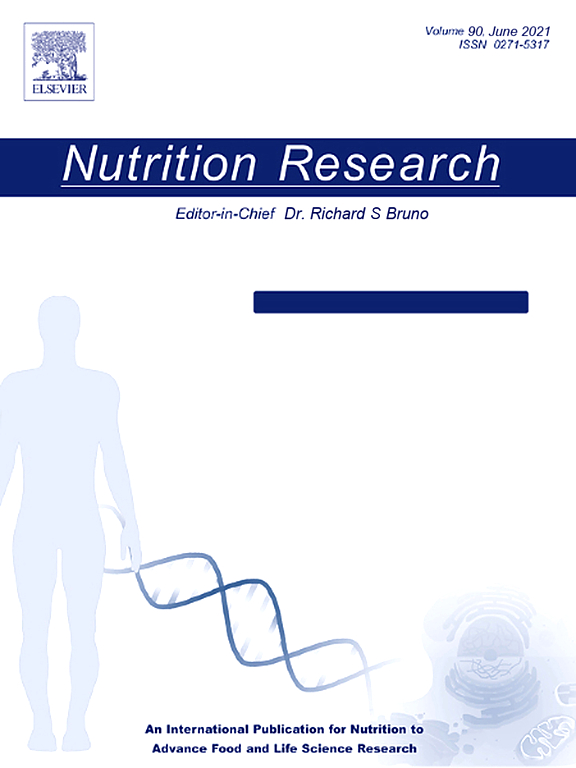Higher serum carotenoid concentrations are associated with lower mortality in adults with advanced cardiovascular-kidney-metabolic syndrome
IF 3.1
3区 医学
Q2 NUTRITION & DIETETICS
引用次数: 0
Abstract
This study aimed to investigate the associations between serum carotenoid concentrations and all-cause mortality among adults with advanced cardiovascular-kidney-metabolic (CKM) syndrome. Data were analyzed from 1285 adults aged ≥20 years with advanced CKM syndrome (stages 3 or 4), identified from the National Health and Nutrition Examination Survey 2001 to 2006 cohort. Five serum carotenoids were assessed as exposures, including α-carotene, β-carotene, lycopene, lutein/zeaxanthin, and total carotenoids. Cox proportional hazards regression models were used to estimate hazard ratios (HRs) and 95% CIs, while quantile g-computation (Qgcomp) regression was employed to examine the joint effects of all carotenoids. During a median follow-up of 11.8 years, 936 (72.8%) deaths were recorded. Age- and sex-standardized all-cause mortality rates decreased across increasing quartiles of several serum carotenoids, most notably lycopene, for which the mortality rate declined from 106.6 (95% CI: 90.1-123.1) per 1000 person-years in the lowest quartile to 62.4 (95% CI: 54.6-70.1) in the highest quartile. Adjusted for potential confounders, higher concentrations of α-carotene (HR = 0.64, 95% CI: 0.49-0.84), β-carotene (HR = 0.76, 95% CI: 0.61-0.95), lutein/zeaxanthin (HR = 0.75, 95% CI: 0.59-0.96), lycopene (HR = 0.63, 95% CI: 0.49-0.81), and total carotenoids (HR = 0.81, 95% CI: 0.66-1.00) were significantly associated with lower all-cause mortality, while no significant association was observed for β-cryptoxanthin. Qgcomp regression demonstrated a significant joint protective effect of serum carotenoids on all-cause mortality (HR = 0.87, 95% CI: 0.79-0.95, P < .01), with lycopene contributing the most to the overall protective effect. In conclusion, the joint effect of serum carotenoids was independently associated with lower all-cause mortality in adults with advanced CKM syndrome, with lycopene showing the strongest contribution among the 5 carotenoids studied.

较高的血清类胡萝卜素浓度与晚期心血管-肾脏代谢综合征成人的较低死亡率相关
本研究旨在探讨成人晚期心血管-肾脏代谢综合征(CKM)患者血清类胡萝卜素浓度与全因死亡率之间的关系。数据分析了1285名年龄≥20岁的晚期CKM综合征(3期或4期)成人,这些数据来自2001年至2006年的国家健康与营养调查队列。五种血清类胡萝卜素被评估为暴露,包括α-胡萝卜素、β-胡萝卜素、番茄红素、叶黄素/玉米黄质和总类胡萝卜素。采用Cox比例风险回归模型估计风险比(hr)和95% ci,采用分位数g计算(Qgcomp)回归检验所有类胡萝卜素的联合效应。在中位11.8年的随访期间,记录了936例(72.8%)死亡。在几种血清类胡萝卜素含量增加的四分位数中,年龄和性别标准化的全因死亡率下降,最明显的是番茄红素,其死亡率从最低四分位数的每1000人年106.6 (95% CI: 90.1-123.1)下降到最高四分位数的每1000人年62.4 (95% CI: 54.6-70.1)。校正潜在混杂因素后,较高浓度的α-胡萝卜素(HR = 0.64, 95% CI: 0.49-0.84)、β-胡萝卜素(HR = 0.76, 95% CI: 0.61-0.95)、叶黄素/玉米黄质(HR = 0.75, 95% CI: 0.59-0.96)、番茄红素(HR = 0.63, 95% CI: 0.49-0.81)和总类胡萝卜素(HR = 0.81, 95% CI: 0.66-1.00)与较低的全因死亡率显著相关,而β-隐黄质则无显著相关性。Qgcomp回归显示血清类胡萝卜素对全因死亡率有显著的联合保护作用(HR = 0.87, 95% CI: 0.79-0.95, P <;.01),其中番茄红素对整体保护作用的贡献最大。综上所述,血清类胡萝卜素的联合作用与晚期CKM综合征成人全因死亡率的降低独立相关,其中番茄红素在5种类胡萝卜素中贡献最大。
本文章由计算机程序翻译,如有差异,请以英文原文为准。
求助全文
约1分钟内获得全文
求助全文
来源期刊

Nutrition Research
医学-营养学
CiteScore
7.60
自引率
2.20%
发文量
107
审稿时长
58 days
期刊介绍:
Nutrition Research publishes original research articles, communications, and reviews on basic and applied nutrition. The mission of Nutrition Research is to serve as the journal for global communication of nutrition and life sciences research on diet and health. The field of nutrition sciences includes, but is not limited to, the study of nutrients during growth, reproduction, aging, health, and disease.
Articles covering basic and applied research on all aspects of nutrition sciences are encouraged, including: nutritional biochemistry and metabolism; metabolomics, nutrient gene interactions; nutrient requirements for health; nutrition and disease; digestion and absorption; nutritional anthropology; epidemiology; the influence of socioeconomic and cultural factors on nutrition of the individual and the community; the impact of nutrient intake on disease response and behavior; the consequences of nutritional deficiency on growth and development, endocrine and nervous systems, and immunity; nutrition and gut microbiota; food intolerance and allergy; nutrient drug interactions; nutrition and aging; nutrition and cancer; obesity; diabetes; and intervention programs.
 求助内容:
求助内容: 应助结果提醒方式:
应助结果提醒方式:


